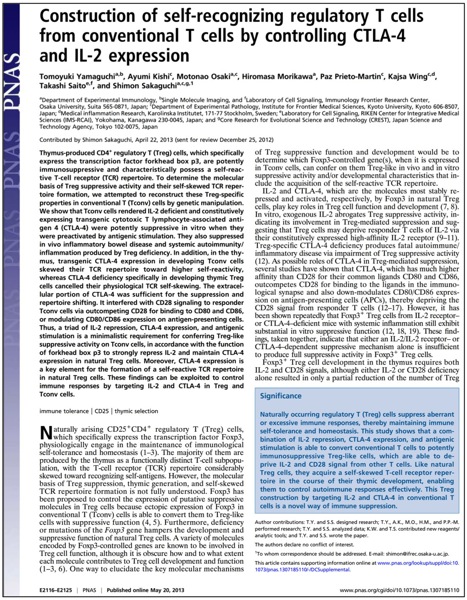Yamaguchi.T et al. Construction of self-recognizing regulatory T cells from conventional T cells by controlling CTLA-4 and IL-2 expression. Proc Natl Acad Sci U S A 110, E2116-2125 (2013).

Abstract:
Thymus-produced CD4(+) regulatory T (Treg) cells, which specifically express the transcription factor forkhead box p3, are potently immunosuppressive and characteristically possess a self-reactive T-cell receptor (TCR) repertoire. To determine the molecular basis of Treg suppressive activity and their self-skewed TCR repertoire formation, we attempted to reconstruct these Treg-specific properties in conventional T (Tconv) cells by genetic manipulation. We show that Tconv cells rendered IL-2 deficient and constitutively expressing transgenic cytotoxic T lymphocyte-associated antigen 4 (CTLA-4) were potently suppressive in vitro when they were preactivated by antigenic stimulation. They also suppressed in vivo inflammatory bowel disease and systemic autoimmunity/inflammation produced by Treg deficiency. In addition, in the thymus, transgenic CTLA-4 expression in developing Tconv cells skewed their TCR repertoire toward higher self-reactivity, whereas CTLA-4 deficiency specifically in developing thymic Treg cells cancelled their physiological TCR self-skewing. The extracellular portion of CTLA-4 was sufficient for the suppression and repertoire shifting. It interfered with CD28 signaling to responder Tconv cells via outcompeting CD28 for binding to CD80 and CD86,or modulating CD80/CD86 expression on antigen-presenting cells. Thus, a triad of IL-2 repression, CTLA-4 expression, and antigenic stimulation is a minimalistic requirement for conferring Treg-like suppressive activity on Tconv cells, in accordance with the function of forkhead box p3 to strongly repress IL-2 and maintain CTLA-4 expression in natural Treg cells. Moreover, CTLA-4 expression is a key element for the formation of a self-reactive TCR repertoire in natural Treg cells. These findings can be exploited to control immune responses by targeting IL-2 and CTLA-4 in Treg and Tconv cells.
